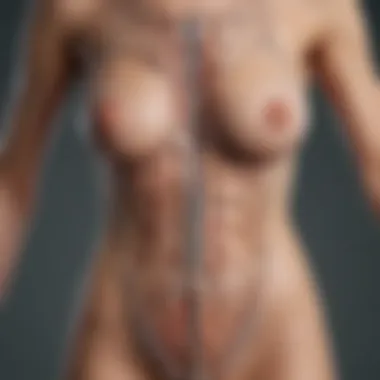Understanding Nerve Pain After Breast Reconstruction


Intro
Nerve pain after latissimus dorsi breast reconstruction is a complex issue faced by many patients. Understanding this condition is vital not only for those undergoing such procedures but also for healthcare professionals involved in their care. This type of nerve pain can arise due to various causes, including surgical trauma, inflammation, and altered nerve pathways.
Patients often experience unique symptoms ranging from sharp, shooting pain to persistent throbbing discomfort. Recognizing these symptoms and their implications is crucial in tailoring effective treatment strategies. Furthermore, the psychological aspects of coping with postoperative pain can significantly impact a patient's overall recovery and quality of life. Consequently, a comprehensive approach to understanding nerve pain is necessary.
In this article, we will explore the different facets of nerve pain after latissimus dorsi breast reconstruction, focusing on its causes, implications, and potential management strategies. This understanding is aimed at providing insight for both patients and medical practitioners alike.
Prologue to Latissimus Dorsi Breast Reconstruction
Latissimus dorsi breast reconstruction is a surgical procedure widely recognized for its role in restoring breast volume and shape after mastectomy. This approach is both functional and aesthetic, aiming to utilize the patient’s own tissue for reconstruction. Understanding this procedure is crucial, particularly in the context of postoperative outcomes, as nerve pain is a common complication that can significantly affect recovery and quality of life. In this section, we will delve into various aspects of the latissimus dorsi reconstruction, highlighting what makes it a relevant topic within the broader scope of post-surgical nerve pain experiences.
Overview of the Procedure
Latissimus dorsi breast reconstruction involves relocating a portion of the latissimus dorsi muscle from the back to the chest area. This technique is often chosen for its effectiveness in creating a natural-looking breast shape using autologous tissue. The procedure typically requires an extensive preoperative assessment to ensure the patient is a suitable candidate.
Before the surgery, a thorough discussion occurs between the surgeon and the patient regarding expectations, the surgical process, and potential risks. Anesthesia is administered to ensure the patient is comfortable during the operation. The surgeon makes an incision in the back to detach the muscle while preserving its blood supply. Subsequently, the muscle is swung around to the front and shaped to form the breast mound. The procedure may be combined with implants, especially if additional volume is required.
Indications for Surgery
Several factors can prompt the decision for latissimus dorsi breast reconstruction. The most prevalent indication is breast cancer treatment, particularly for those who have undergone lumpectomy or mastectomy. Other considerations include:
- Personal preference: Many patients wish to regain their breast shape after cancer removal for psychological and emotional well-being.
- Availability of donor tissue: The latissimus dorsi muscle is typically sufficient for some women; however, it is essential for the individual to have adequate body mass.
- Previous surgeries: Patients with a history of radiation treatments may find this technique beneficial when other options are less effective.
Potential Complications
Like any surgical procedure, latissimus dorsi breast reconstruction can have complications. Some potential risks include:
- Nerve pain: As discussed in upcoming sections, postoperative nerve pain can interfere with rehabilitation and overall recovery.
- Infection: Post-surgical infections can arise and may require additional interventions.
- Scarring: Incisions can lead to varied scarring based on individual healing processes.
- Seroma or hematoma: Fluid collections may form, necessitating further drainage.
It is worthwhile to note that thorough preoperative discussions can help patients understand these potential risks better.
In summary, the latissimus dorsi breast reconstruction is a significant surgical option with its distinct protocols and considerations. Recognizing the importance of postoperative nerve pain awareness and its various implications sets the scene for deeper investigation into this aspect.
Understanding Nerve Pain
Nerve pain following latissimus dorsi breast reconstruction represents a significant aspect of the postoperative experience for many patients. Understanding this topic is crucial for several reasons. First, it helps patients and healthcare providers to navigate the complexities of recovery. Postoperative nerve pain can influence how effectively a patient engages in rehabilitation, impacting both physical recovery and the overall quality of life. Furthermore, grasping the nature of nerve pain allows for better communication between patients and their care teams. This can lead to more customized treatment plans and improved outcomes.
Definition of Nerve Pain
Nerve pain, or neuropathic pain, arises from damage or dysfunction of the nervous system. This type of pain is distinct from nociceptive pain, which results from tissue injury. Nerve pain is often described as burning, tingling, or shooting sensations. It can occur even when there is no apparent injury. This phenomenon occurs due to altered nerve signaling in response to injury or surgical intervention. In the context of latissimus dorsi breast reconstruction, nerve pain may develop as a result of the surgical techniques used, affecting the surrounding nerve structures.
Causes of Nerve Pain
Numerous factors contribute to the development of nerve pain after surgery, particularly following latissimus dorsi breast reconstruction. The main causes include:
- Surgical Trauma: The procedure may directly damage nerves or disrupt their function. This is perhaps the most straightforward cause, as surgical manipulation inherently carries a risk to nerve integrity.
- Scarring: Post-operative scarring can compress or irritate nerves, leading to pain. Fibrous tissue can form around nerves as they heal, which may alter their normal function.
- Partial Nerve Transection: In some cases, nerves may be partially cut during surgery. This can lead to abnormal nerve signaling and, subsequently, pain.
- Inflammation: Surgical intervention can trigger inflammatory responses, which may affect nerve tissues and contribute to pain sensation.
- Neuromas: These are abnormal growths of nerve tissue that may form when nerves attempt to heal after being cut or injured. Neuromas can be painful and contribute to neuropathic pain symptoms.
Understanding these causes is essential for effective management and treatment of nerve pain. It allows medical professionals to anticipate potential complications and engage in preemptive strategies for mitigating pain.
Postoperative Nerve Pain After Latissimus Dorsi Reconstruction


Nerve pain is a significant concern in the aftermath of latissimus dorsi breast reconstruction. Understanding the nature of this pain is essential for both patients and healthcare providers. Postoperative nerve pain can hinder recovery, complicate rehabilitation, and exacerbate emotional distress. This highlights the need for tailored management strategies.
Mechanisms Behind Nerve Pain
Nerve pain arises from a variety of mechanisms. When the latissimus dorsi muscle is used in reconstruction, it involves surgical manipulation of nerves. Injury or irritation to these nerves can lead to neuropathic pain, characterized by a burning or shooting sensation. Furthermore, there may be changes in nerve signaling following surgery, causing the brain to interpret normal sensations as pain. This process is complex and multifaceted, impacting how patients experience recovery.
Nerve pain following surgery isn't just a symptom; it reflects underlying biological changes that require careful assessment.
It is important to distinguish between nociceptive pain, which is caused by tissue damage, and neuropathic pain, arising from nerve injury. Effective management begins with understanding these pain types and their root causes.
Incidence and Prevalence
The incidence of postoperative nerve pain varies among patients. Studies indicate that approximately 20% to 40% of individuals may experience some form of nerve-related discomfort after latissimus dorsi reconstruction. Factors influencing prevalence include the extent of the surgery, individual pain thresholds, and pre-existing conditions.
In a clinical setting, documenting the incidence of nerve pain becomes crucial for developing comprehensive care plans. Moreover, understanding patient demographics helps in identifying those at higher risk. Prevalence figures emphasize the necessity for ongoing research into effective prevention and treatment strategies.
In summary, postoperative nerve pain is an important aspect of latissimus dorsi breast reconstruction. Recognizing the mechanisms behind this pain and its prevalence equips healthcare providers with the knowledge necessary for better managing patient expectations and outcomes.
Clinical Implications of Nerve Pain
Nerve pain after latissimus dorsi breast reconstruction has significant clinical implications that must be understood by healthcare providers. This type of pain often affects not just the physical aspects of recovery but also the psychological well-being of patients. Awareness of these implications can shape treatment approaches and enhance patient outcomes.
Impact on Rehabilitation
Rehabilitation plays a crucial role in recovery following breast reconstruction. The presence of nerve pain can substantially hinder progress. Patients may experience reduced mobility, limited range of motion, and even changes in muscle function due to discomfort.
- Pain Management Strategies: Effective pain management is essential in physical therapy. When a patient feels pain, they are likely to avoid certain movements, which can impede rehabilitation. Tailored pain management strategies can help improve participation in therapy sessions.
- Therapeutic Exercises: Specific exercises must be adapted to accommodate nerve pain. Therapists may need to modify routines to ensure that they do not exacerbate discomfort. This means a careful assessment of pain levels and adjustments as necessary.
- Patient Education: Educating patients about the nature of nerve pain can help them understand their experiences. This can lead to a more proactive approach in rehabilitation, where patients are engaged in their recovery process.
Effects on Quality of Life
Nerve pain can significantly diminish a patient’s quality of life. Its effects can be extensive, influencing both physical and emotional well-being.
- Daily Activities: Persistent pain can interfere with daily functions such as dressing, bathing, and other routine tasks. This level of disruption can lead to feelings of frustration and dependency, impacting self-esteem.
- Psychological Impact: The emotional toll of enduring chronic pain cannot be understated. Anxiety and depression are common among patients suffering from nerve pain. Mental health support may be necessary to address these issues and improve overall life satisfaction.
- Social Interactions: Pain can lead to withdrawal from social situations. Patients may isolate themselves due to discomfort or embarrassment about their limitations. This can further exacerbate feelings of loneliness and affect overall well-being.
Research shows that effective pain management and supportive therapies can enhance recovery and improve life satisfaction for patients after latissimus dorsi breast reconstruction.
Overall, understanding the clinical implications of nerve pain allows healthcare professionals to adopt a more holistic approach in managing the complexities surrounding recovery.
Assessment and Diagnosis
Assessment and diagnosis of nerve pain following latissimus dorsi breast reconstruction is critical. Proper evaluation helps in understanding the extent of nerve involvement and pain levels that patients experience after surgery. This section provides insights into various techniques and tools available for accurate diagnosis, which ultimately aids in effective management and treatment strategies.
Clinical Evaluation Techniques
Clinical evaluation techniques are the foundation of assessing nerve pain. These methods involve gathering comprehensive information about the patient’s medical history, surgical background, and current symptoms. Healthcare providers often start with a detailed interview to establish when the pain began, its location, and its intensity. Some important aspects to consider during evaluation include:
- Pain Scale: Using a standardized pain scale, such as the Numerical Rating Scale (NRS), can help quantify the pain and understand its severity.
- Physical Examination: Conducting a thorough physical examination allows doctors to assess the affected areas, identify any sensory loss, and check for reflex reactions.
- Medical History Review: Documenting the patient’s medical history and any pre-existing conditions can provide context to their post-operative pain.
Through these techniques, health professionals can build a clearer picture of the patient’s situation, which is essential for a targeted approach in further diagnostics.
Diagnostic Tools
Various diagnostic tools assist in the detailed analysis of nerve pain following surgery. These tools help in confirming the diagnosis and ruling out other conditions that may mimic nerve pain. They include:


- Electromyography (EMG): This test evaluates the electrical activity of muscles and helps to detect nerve damage or dysfunction.
- Nerve Conduction Studies (NCS): By assessing how well electrical signals travel through the nerves, this test can identify abnormalities in nerve function.
- Imaging Techniques: Techniques like MRI or ultrasound can visualize any anatomical changes or injuries that might be contributing to nerve pain.
"A comprehensive diagnostic approach enhances the ability to tailor effective treatment plans for patients experiencing nerve pain post-surgery."
Employing these diagnostic tools not only aids in confirming the nerve pain diagnosis but also guides treatment decisions. The combination of clinical evaluation techniques and diagnostic tools forms a robust framework for addressing post-operative nerve pain effectively. Proper assessment is integral not only for symptom management but also for improving the overall quality of care for patients.
Management Strategies for Nerve Pain
Managing nerve pain following latissimus dorsi breast reconstruction is critical for enhancing patient recovery and improving quality of life. This section discusses various management strategies, focusing on their effectiveness, benefits, and considerations. By incorporating multiple approaches, patients can achieve better outcomes and find relief from distressing symptoms.
Pharmacological Approaches
Pharmacological interventions are often the first line of treatment for nerve pain. Medications can help in reducing pain intensity and improving functionality. Commonly used pharmacological options include:
- Gabapentin and Pregabalin: These medications are anticonvulsants that have shown efficacy in treating neuropathic pain. They work by modulating neurotransmitter release in the nervous system, thus alleviating pain symptoms.
- Tricyclic Antidepressants: Drugs like amitriptyline can also be effective. These medications help not only with mood stabilization but also with pain relief by affecting the way the brain processes pain signals.
- Opioids: In certain cases, stronger pain relief may be necessary. Short-term use of opioids can be beneficial in managing severe pain, but they carry risks of dependence and side effects that must be carefully monitored.
It is essential for healthcare providers to tailor medication choices to the individual patient, considering their overall health, pain severity, and potential drug interactions.
Physical Therapy Interventions
Physical therapy plays a key role in managing nerve pain after surgery. Interventions focus on improving range of motion, strength, and overall physical function. Important elements of this approach include:
- Manual Therapy: This hands-on technique enhances blood flow and alleviates tension in affected areas. It also aids in reducing pain and improving mobility.
- Exercise Regimens: A personalized exercise program can enhance physical strength and flexibility. Low-impact activities, such as swimming or walking, may be beneficial. These activities stimulate the nervous system and can promote healing.
- Neuromuscular Re-education: This method improves the brain's ability to respond to nerve pain. Patients learn strategies to minimize discomfort while safely enhancing mobility.
Physical therapy must be initiated under the guidance of a qualified therapist to ensure the right strategies are employed based on individual needs and pain levels.
Psychological Support and Counseling
Psychological support is vital in managing chronic nerve pain. Emotional and mental health significantly influence the perception of pain. Effective strategies include:
- Cognitive Behavioral Therapy (CBT): This form of therapy helps patients understand their pain's emotional aspects. Patients learn coping mechanisms to reduce anxiety and depression associated with chronic pain.
- Mindfulness and Relaxation Techniques: Practices such as mindfulness meditation can help patients manage stress. Learning to focus on the present can alleviate pain tension and improve overall well-being.
- Support Groups: Connecting with others facing similar challenges can provide emotional solace. Sharing experiences can foster a sense of community and reduce feelings of isolation.
It is important for healthcare providers to recognize the psychological dimensions of pain and to incorporate support systems that address these needs.
Proper management of nerve pain requires a comprehensive understanding of the various options available. An interdisciplinary approach can significantly enhance patient care and recovery.
Multi-disciplinary Approaches to Treatment
In the context of nerve pain following latissimus dorsi breast reconstruction, a multi-disciplinary approach becomes vital. This method integrates diverse expertise to provide comprehensive care, addressing both physiological and psychological aspects of recovery. As nerve pain can result from various sources, tailored solutions are necessary for effective management.
A multi-disciplinary team typically includes surgeons, pain specialists, physical therapists, and psychologists. Each professional brings unique insights and strategies, which enhance patient outcomes. Collaborative discussions among these experts enable a holistic understanding of a patient’s condition, leading to personalized treatment plans.
Role of Surgeons
Surgeons play a pivotal role in the management of postoperative nerve pain. Their expertise helps identify potential complications during the surgical process that can lead to nerve irritation or damage. By employing precise surgical techniques, surgeons can minimize the risks associated with nerve pain.
Post-operatively, they monitor the patient’s recovery and assess for signs of nerve involvement. Surgeries may require follow-ups to address any unexpected development in nerve pain. If pain persists, surgeons can work together with pain management experts to adjust treatment protocols effectively. This partnership ensures that any surgical approach aligns with ongoing pain management initiatives.
Involvement of Pain Specialists
Pain specialists are essential in the treatment of nerve pain. They have advanced knowledge about the mechanisms underlying pain, and their focus is to alleviate this distress. After surgery, patients may experience different types of pain, and understanding these can guide interventions.


Pain specialists utilize a variety of techniques, including:
- Medications
- Nerve blocks
- Interventional procedures
These methods can effectively reduce symptoms and improve patient quality of life. Their involvement ensures that patients receive specialized care tailored to their specific pain profile, fostering a faster and more efficient recovery.
Importance of Collaboration with Psychologists
Psychologists add a crucial layer to the multi-disciplinary approach by addressing the emotional and psychological impact of nerve pain. Chronic pain can lead to anxiety, depression, and other mental health concerns. Hence, it is essential to evaluate the patient’s mental state consistently.
Through cognitive-behavioral therapy and other interventions, psychologists help patients develop coping strategies. This support can lead to improved adherence to treatment plans and better overall satisfaction with care. Furthermore, the psychological aspect of pain management fosters resilience among patients, empowering them to participate actively in their recovery process.
Integrating mental health professionals in pain management enhances the overall treatment efficacy, allowing for a more rounded approach to patient care.
Ultimately, the collective efforts of surgeons, pain specialists, and psychologists pave the way for a more effective management strategy. This collaboration not only addresses the physical symptoms of nerve pain but also its emotional consequences, enhancing the patient's recovery journey significantly.
Future Directions in Research
The study of nerve pain following latissimus dorsi breast reconstruction is an evolving field. Breaking new ground in understanding this condition not only enhances patient care but also expands knowledge in surgical and pain management disciplines. This section highlights the necessity for continual research, targeting different facets of nerve pain management and the impact it has on recovery.
Emerging Treatments
The development of innovative treatments is crucial in managing nerve pain. Several promising therapies have been researched and could change how patients experience relief after latissimus dorsi breast reconstruction. Here are a few noteworthy developments:
- Transcranial Magnetic Stimulation: This non-invasive procedure uses magnetic fields to stimulate nerve cells in the brain. Preliminary studies suggest it might help reduce chronic pain, including nerve pain.
- Peripheral Nerve Stimulation: This technique involves implanting a device that sends electrical impulses to a specific nerve. Research has shown effectiveness in reducing pain intensity.
- Platelet-Rich Plasma (PRP) Injections: Derived from a patient’s own blood, PRP is injected into the painful areas to promote healing. Initial findings indicate it may enhance nerve recovery.
- Gene Therapy Approaches: Studies exploring gene therapy to produce growth factors could potentially repair damaged nerve pathways.
As these emerging treatments undergo further clinical trials, they may offer improved outcomes for patients experiencing nerve pain.
Research Gaps and Opportunities
Despite the strides made, there remain significant gaps in the literature concerning nerve pain management after latissimus dorsi reconstruction. These gaps present opportunities for further exploration. Some crucial areas include:
- Longitudinal Studies: More long-term research is needed to understand how nerve pain evolves over time and what factors influence its trajectory.
- Diverse Populations: Investigating how different demographic factors, such as age, ethnicity, and comorbidities, affect the incidence and severity of nerve pain could yield important insights.
- Integrated Pain Management Models: Research into effective multidisciplinary approaches that combine surgical, pharmacological, and psychological strategies may improve outcomes. Opportunities exist to explore how these models can be better implemented in clinical settings.
- Patient Education and Empowerment: Understanding the most effective ways to inform patients about nerve pain management and rehabilitation can lead to greater engagement and adherence to treatment plans.
Efforts to address these research gaps can lead to improved methodologies, enhanced patient care, and ultimately, a better quality of life for those affected by nerve pain after surgical procedures.
"Research must be ongoing, with sufficient funding allocated to explore all potential avenues for nerve pain management. The goal is to improve both outcomes and patient satisfaction."
By focusing on these areas and fostering collaboration among medical professionals, there is potential for significant advancements in the treatment and management of nerve pain post-latissimus dorsi breast reconstruction.
Finale
The conclusion of an article focused on nerve pain after latissimus dorsi breast reconstruction serves as a critical component for synthesizing the information presented. Clear summaries of key findings clarify the implications of nerve pain for patients and medical providers. Reflecting on the multifaceted nature of nerve pain, the conclusion encapsulates various dimensions such as physical discomfort, psychological impact, and overall quality of life. It is vital to understand how nerve pain may affect rehabilitation and recovery. Thus, contrasting the physiological aspects of pain with psychological support becomes necessary.
The benefits of a thorough conclusion are notable. It reinforces the significance of interdisciplinary collaboration, urging medical professionals to adopt a multi-faceted approach toward treatment. A generalized understanding of nerve pain forms a basis for tailored patient care, enhancing the recovery process. Most importantly, recommendations distilled from research can guide both patients and providers in achieving optimal outcomes.
Summary of Key Findings
This article elucidates several critical points regarding nerve pain after latissimus dorsi breast reconstruction, including:
- Nerve pain mechanisms: The nerve damage during surgery can result in acute or chronic pain, significantly affecting the patient's postoperative experience.
- Incidence and prevalence: Nerve pain is a common postoperative issue, with varying rates of occurrence based on several clinical factors.
- Impact on rehabilitation: The presence of nerve pain can hinder the effectiveness of physical therapy programs, delaying recovery and potentially leading to long-term complications.
- Psychological implications: Emotional well-being plays a significant role in recovery; anxiety and depression related to chronic nerve pain warrant careful attention.
- Treatment options: A variety of pharmacological and non-pharmacological approaches can alleviate nerve pain, highlighting the importance of personalized medical interventions.
Understanding these key findings is essential for healthcare providers to support patients by enhancing treatment strategies.
Recommendations for Patients and Providers
Both patients and medical providers can benefit from the following recommendations:
- Comprehensive Assessment: Encourage healthcare professionals to conduct thorough assessments for nerve pain to pinpoint origins and appropriate treatment pathways.
- Multidisciplinary Collaboration: Maintain a close relationship between surgeons, pain specialists, and mental health professionals to ensure holistic care.
- Patient Education: Inform patients about potential nerve pain and its management early on, empowering them in their own recovery journey.
- Continuous Monitoring: Regularly evaluate pain management effectiveness and adjust strategies as necessary.
- Mental Health Support: Provide resources for psychological support to address emotional distress arising from chronic pain conditions.



